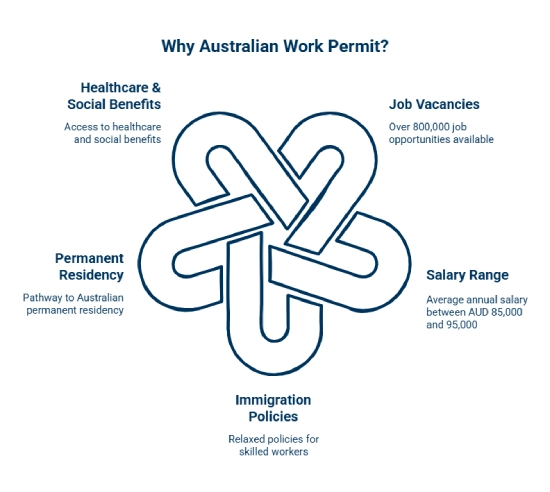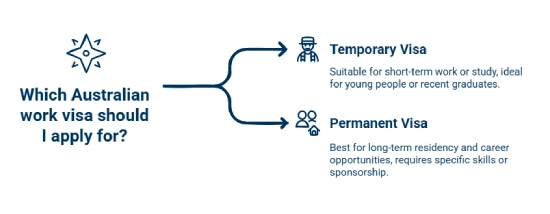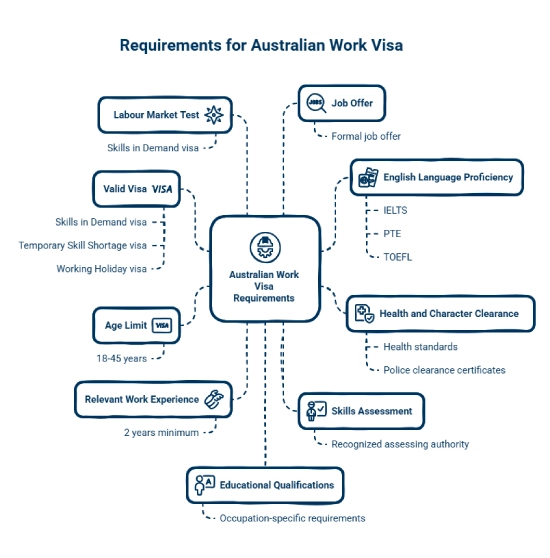
A work permit in Australia is an official authorization that allows foreign nationals, including residents of the UK, to work legally in the country. Issued by the Australian government, this permit is typically linked to a relevant visa type, based on the applicant’s occupation and employment terms. Australia offers both temporary and permanent work permit pathways, and the type you choose depends on your qualifications, job offer, and long-term plans. For UK professionals looking to explore opportunities in Australia, a valid work permit is the first step toward building a career in one of the world’s most stable and dynamic job markets.
Australia remains a popular destination for skilled UK professionals seeking global career opportunities. With over 800,000 job openings projected across key industries in 2025, the Australian job market is actively welcoming international talent, including UK citizens. UK applicants can explore multiple visa options such as the Skills in Demand Visa (replacing the former TSS), which offers a pathway to both temporary work and permanent residency. The similarities in work culture and language also make the transition smoother for UK residents seeking long-term employment in Australia.
Australia is known for more than just its beautiful landscapes, it also promises a high quality of life for those who choose to live and work there. From competitive salaries and strong workplace protections to public healthcare and excellent work-life balance, it is a place where professionals can thrive. For UK residents, working in Australia offers the chance to build a fulfilling career while enjoying the laid-back lifestyle and diverse culture the country is famous for.
Australia offers a variety of work visa options to support its growing economy and meet labour market needs. Whether you are looking to work temporarily or settle permanently, there are specific visa pathways tailored for skilled professionals, graduates, and sponsored workers. Choosing the right visa depends on your occupation, qualifications, and long-term plans.

| Visa Type | Description |
| Skills in Demand Visa (Subclass 482) | Enables Australian employers to sponsor skilled foreign workers for up to 4 years in occupations facing labour shortages. This visa replaced the former Temporary Skill Shortage (TSS) visa. |
| Working Holiday Visa (Subclass 417 & 462) | Designed for young people (aged 18–30 or 35 depending on nationality) to holiday and work in Australia for up to 12 months. |
| Temporary Graduate Visa (Subclass 485) | Allows recent graduates from Australian institutions to live, study, and work in Australia temporarily, depending on their qualification. |
| Temporary Activity Visa (Subclass 408) | For short-term work in cultural, social, or research-based projects and events. |
| Visa Type | Description |
| Skilled Independent Visa (Subclass 189) | A points-tested visa for skilled workers who are not sponsored. It grants permanent residency and allows applicants to live and work anywhere in Australia. |
| Skilled Nominated Visa (Subclass 190) | For skilled professionals nominated by an Australian state or territory. This is a permanent visa offering a pathway to citizenship. |
| Employer Nomination Scheme Visa (Subclass 186) | Permits skilled workers to be sponsored by an Australian employer for permanent residence. It includes Direct Entry and Temporary Residence Transition streams. |
| Regional Sponsored Migration Scheme (Subclass 191) | For skilled migrants who have lived and worked in designated regional areas of Australia for at least three years. Grants permanent residency. |
Australia’s Core Skills Occupation List (CSOL) outlines key roles that are in high demand across the country. This list is designed to help skilled professionals from overseas find opportunities that match Australia’s workforce needs. If your occupation appears on the CSOL, you may be eligible to apply for skilled migration pathways, making it an important factor for anyone planning to live and work in Australia.
Read more…
Australia Core Skills Occupation List (CSOL)
Some of the benefits of working in Australia include:

To be eligible for an Australian work visa, applicants must typically meet criteria related to age, skills, qualifications, and health.
The table below has details of the eligibility criteria for an Australian work visa:
| Category | Maximum Points |
| Age (25-32 years) | 30 points |
| English proficiency (8 bands) | 20 points |
| Work Experience outside Australia (8-10 years) | 15 points |
| Work Experience in Australia (8-10 years) | 20 points |
| Education (outside Australia) – Doctorate degree | 20 points |
| Niche skills such as Doctorate or master’s degree by research in Australia | 10 points |
| Study in a regional area | 5 points |
| Accredited in community language | 5 points |
| Professional year in a skilled program in Australia | 5 points |
| State sponsorship (190 visa) | 5 points |
| Skilled spouse or de facto partner (Age, Skills & English language requirements to be met) | 10 points |
| Spouse or de facto partner with ‘competent English’ (No need to meet Skills requirement or age factor) | 5 points |
| Applicants without a spouse or de facto partner or where a spouse is an Australia citizen or PR holder | 10 points |
| Relative or regional sponsorship (491 visa) | 15 points |
You must fulfil the below list of requirements for an Australian work visa:

If you are planning to apply for a skilled visa to Australia, such as the Subclass 189, 190, or 491, a Skills Assessment is one of the most important steps in your application. This process helps Australian authorities verify that your qualifications and work experience meet the required standards for your nominated occupation. Each profession is assessed by a designated authority like ACS for IT roles or Engineers Australia for engineering occupations. A positive skills assessment confirms that your expertise aligns with Australian workplace expectations and makes you eligible to move forward with your visa process. Most assessments remain valid for up to three years, giving you ample time to plan your migration confidently.
You can follow the below steps to apply for a job in Australia from the UK:
Step 1: Check if your job is on the Skilled Occupation List
Confirm that your profession is eligible for skilled migration or employer-sponsored visas.
Step 2: Get your skills assessed
Apply for a formal skills assessment through the relevant Australian authority.
Step 3: Take an English language test
Meet the required IELTS or PTE scores to qualify for a visa.
Step 4: Search and apply for jobs in Australia
Use portals like SEEK or CareerOne and tailor your CV to local standards.
Step 5: Secure a job offer or sponsorship
If applying for a sponsored visa, get a valid offer from an Australian employer.
Step 6: Apply for a suitable work visa
Choose from options like the Skills in Demand visa or Skilled Independent visa.
Step 7: Move to Australia and start working
Once approved, relocate and begin your new career in Australia.
| Visa Type | Median Processing Time |
| Skills in Demand Visa (Subclass 482) | 44 days |
| Skilled Independent Visa (Subclass 189) | 10 months |
| Skilled Nominated Visa (Subclass 190) | 10 months |
| Employer Nomination Scheme (Subclass 186) | 10 months |
| Skilled Work Regional (Provisional) Subclass 491 | 10 months |
| Working Holiday Visa (Subclass 417 & 462) | Less than 1 day |
| Temporary Graduate Visa (Subclass 485) | 52 days |
| Visa Type | Base Application Fee (AUD) | Additional Applicant Over 18 (AUD) | Additional Applicant Under 18 (AUD) |
| Skills in Demand Visa (Subclass 482) | $1,495 – $3,115 | $1,495 – $3,115 | $375 – $780 |
| Employer Nomination Scheme (Subclass 186) | $4,770 | $2,385 | $1,190 |
| Skilled Independent Visa (Subclass 189) | $4,765 | $2,385 | $1,190 |
| Skilled Nominated Visa (Subclass 190) | $4,765 | $2,385 | $1,190 |
| Skilled Work Regional (Provisional) Visa (Subclass 491) | $4,765 | $2,385 | $1,190 |
| Temporary Graduate Visa (Subclass 485) | $1,920 | $960 | $485 |
| Temporary Work (Short Stay Specialist) Visa (Subclass 400) | $415 | $415 | $80 |
| Working Holiday Visa (Subclass 417 & 462) | $650 | N/A | N/A |
Australia offers excellent job opportunities for UK residents, thanks to its strong economy, high demand for skilled professionals, and transparent visa pathways. With over 800,000 job vacancies across key sectors like healthcare, IT, and engineering, UK citizens with in-demand skills and qualifications are well-positioned to secure employment and long-term career growth in Australia.
| Occupation | Annual Salary in (AUD) |
| IT | $99,642 – $ 115, 000 |
| Marketing & Sales | $84,072 – $103,202 |
| Engineering | $92,517 – $110,008 |
| Hospitality | $60,000 – $75,000 |
| Healthcare | $101,569- $169279 |
| Accounting & Finance | $77,842 – $92,347 |
| Human Resources | $80,000 – $99,519 |
| Construction | $72,604 – $99,552 |
| Professional and Scientific Services | $90,569 – $108,544 |
Y-Axis, the leading overseas immigration consultancy in the UK, provides unbiased immigration services for every client based on their interests and requirements.
The impeccable services of Y-Axis include:
Explore what Global Citizens have to say about Y-Axis in shaping their future
Australia Skilled Migration Visa
One of our client Kavitha applied for Au
Read More...
Australia PR Visa
Ms. Subhashini got Australia Permanent R
Read More...
Australia PR Visa
Our client Varun Mathur gave a good feed
Read More...
You can stay in Australia for 12 months to 4 years depending on the category of your Work Visa. If it is under the RSMS or ENS, you can stay indefinitely as long as you remain sponsored under these schemes.
The requirements to work in Australia through the Skilled Visa are:
In case of Nurses the IELTS (academic module) with a minimum overall score of 7 and a minimum score of 7 in each of the four components (listening, reading, writing and speaking) to apply for registration as an enrolled nurse. Applicants can also undergo OET, TOEFL or PTE (Academic) English tests.
UK residents can apply online for an Australian work permit through the Australian Department of Home Affairs website. You’ll need to choose the appropriate visa stream, gather supporting documents (job offer, skills assessment, proof of English, etc.), and meet health and character requirements. It is also common to apply through the Employer Nomination Scheme or Skilled Migration Program.
Yes, in most cases, a proof of English language proficiency is mandatory. The IELTS General Training test is one of the most commonly accepted, with minimum score requirements depending on the visa subclass. Some applicants may submit scores from alternative approved tests like PTE Academic, TOEFL iBT, or OET.
The Australia Work Visa processing times will again depend on the category of Visa that you have applied. It will also depend on other factors that include:
Nevertheless, it will usually take around 6 to 12 months for processing your Work Visa.
To work and live in Australia, you would be required to apply for any one of the below categories.
Working in Australia depends on the type of Visa you are applying for. However, there are certain general requirements that are given below.
Basically, you should meet all the criteria required by the type of Visa you are applying
If you are applying for an Australian work Visa, it is advised that you take the help of an Australian Immigration Specialist.
The different types of Australian Work Visas are below.
The eligibility conditions for the subclass 408 visa are given below. You must:
The primary requirements for the 408 visa are given below. You must have:
The type of visa you require to work in Australia depends on your job role and the duration you intend to stay in Australia. The Australian work visa must align with your skills. Some of the popular Australian work visas include:
The processing time for Australian work visas varies depending on the type of work visa you have applied for. More information about the processing times of various Australian work visas is given below.
| Type | Processing Time |
|---|---|
| Temporary Skill Shortage (subclass 482) | 8 days to 5 months |
| Employer Nomination Scheme (subclass 186) | 3 months to 14 months |
| Skilled Independent (subclass 189) | 3 months to 25 months |
| Skilled Nominated (subclass 190) | 4 months to 14 months |
Yes, you can move to Australia without a job offer. There are multiple pathways offered to international individuals who do not have an Australian job offer. You can apply for Australian immigration under:
Yes, Australia offers a variety of work visas that act as work permits for foreign nationals. The most popular include the Subclass 482 TSS visa, Subclass 186 Employer Nomination Scheme visa, Subclass 189 Skilled Independent visa, and Subclass 190 Skilled Nominated visa. Each visa type has specific eligibility rules, such as skill requirements, sponsorship, or state/territory nomination. These visas allow professionals to legally work and reside in Australia, either temporarily or permanently. Applicants must meet criteria like skills assessments, English proficiency, health, and character checks, as outlined by the Department of Home Affairs.
The processing times for Australian work visas vary depending on the visa subclass, application volume, and completeness of the application. For example, the Subclass 482 TSS visa is generally processed within 1 to 3 months, while permanent skilled visas such as the Subclass 186 or Subclass 189 may take 6 to 12 months or longer. The Department of Home Affairs regularly updates global processing times on its website. Applicants should ensure all required documents, including skills assessments and health checks, are submitted promptly to avoid unnecessary delays in processing.
A skills assessment is a crucial step for many Australian work visas. Applicants must have their qualifications and work experience formally assessed by the relevant assessing authority designated for their occupation (e.g., Engineers Australia, ACS for ICT professionals, ANMAC for nurses). The process typically involves submitting academic transcripts, proof of work experience, English language test results, and paying an assessment fee. A positive skills assessment confirms that your qualifications meet Australian standards. Without this, skilled visa applications (such as Subclass 189, 190, or 491) cannot proceed. Each assessing authority sets its own detailed requirements and timelines.
Some of the most common and accessible pathways include the Skilled Independent Visa (Subclass 189), which is points-tested and does not require employer sponsorship, making it popular among skilled workers with in-demand qualifications. Another widely used option is the Skills in Demand Visa (Subclass 482), where Australian employers can sponsor skilled foreign workers to fill roles when no suitable local candidates are available. These visas are often considered the easiest because they are either independent of employer ties or directly connected to a confirmed job offer, streamlining the approval process for qualified applicants.
While there is no single public directory listing all companies that sponsor foreign workers, many organizations in industries facing skills shortages regularly sponsor visas. Employers in healthcare, IT, engineering, construction, and mining are among the largest sponsors. Job seekers can identify sponsoring companies by reviewing job advertisements that specifically mention “visa sponsorship” or “482 visa.” Networking on professional platforms and consulting recruitment agencies also helps locate employers experienced in sponsorship. Additionally, companies accredited by the Department of Home Affairs are often active sponsors, as accreditation allows them to streamline the visa application process for workers.
Eligibility depends on the visa stream, but most work visas require that you:
Note: Australia also provides a points calculator tool that helps skilled workers assess their eligibility for permanent or provisional skilled visas. Each application is carefully assessed, and meeting minimum requirements is essential for success.
Australia’s Department of Home Affairs publishes official lists of occupations that are eligible for skilled work visas. These lists are updated regularly to reflect the country’s labour market needs and ensure that migration supports areas facing skill shortages. The main lists include the Medium and Long-Term Strategic Skills List (MLTSSL), the Short-Term Skilled Occupation List (STSOL), the Regional Occupation List (ROL), and in some cases, the Core Skills Occupation List (CSOL). Each visa subclass is tied to a specific list, and checking the latest version helps applicants confirm whether their profession is currently in demand.
Australia offers different work visa pathways for skilled workers. Some of the best Australia work visa options for skilled workers is as follows: